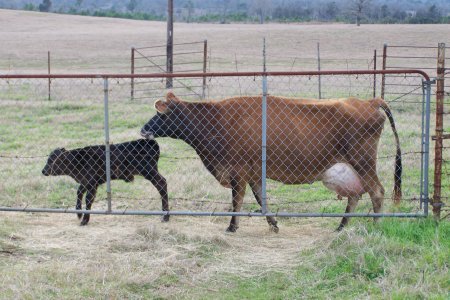TexasJerseyMilker
Well-known member
Back three lactations ago we found Daphne on the ground unable to get up after delivering a big bull calf. Due to inexperience we thought it was from a dystocia, a difficult birth. She was down for three days. We kept water and hay in front of her, turned her every six hours and propped her up with hay bales. Some times she would be found lying head downhill and would bloat so we had to reposition her in the middle of the night using ropes and the tractor. You could not milk anything from her, so I did store bought colostrum and milk replacer. With good care she still could not get up and we were thinking we'd have to shoot her. Then my retired dairyman friend called from Oregon and said Have you thought about milk fever? I gave her one tube of calcium and another a while later. I prayed to God Lord I know thy will be done but please I ask you save my cow. I looked outside a while later and there she was, standing up and that greedy black bull calf sucking away.
Here is the useful advice I found about Milk Fever on a Homesteading board
Discussion Starter · #1 · Apr 20, 2012 (Edited)
" There seems to always be questions on milk fever on here so this is for you all. Milk fever can happen in any breed and any age dairy animals mostly. Some breeds can have milk fever as others don`t near as much. The Jersey breed seems to be one of those breeds that can, but I`m a firm believer that care and feeding can keep most cattle from ever getting it, or mild cases of it at best. Milk fever comes from a rapid draw in calcium from the cows system, and they will have problems real quick if they get it. If you feed your cow good quality grass hay (not timothy) and feed free choice salt and mineral during her dry period she should be fine. Once your cow has her calf keep an eye on your cow, if she has ice cold ears, dry nose, is standoffish, slow on her feet, stumbles, lays down a lot, and at her worst her head will turn around and lay close to her side. Now mild cases of milk fever can be cured on the most part by giving oral calcium in the mouth. The tubes look somewhat like caulking tubes and can be purchased at most farm stores and vet clinics, and you will need the special gun that goes with them. You just put the tube at the back of their mouth on their tongue and press the triger and slowly give her the whole tube. If your cow has been known to have milk fever before, it would be a good idea to give one of these tubes before she has her calf if you can, then another 6 hours after she has it. If giving several of these tubes does not do the trick you should call your vet. to come out and give a calcium solution I.V. to the cow. If the vet does come out to give the I.V. make sure he gives the I.V. slow and never more than one bottle to a small Jersey as two bottles can cause heart attacks. If they need more after one bottle is given a Sub. Q. (under the skin) dose can be given. Make sure you give your cow water after they have their calf , that is VERY important. Warm water in the winter, as they seem to drink it better, I never give mollasses in the water, but know some that do. You can also after they have their calf, give the cow high calcium feed such as good quality alfalfa and good timothy hay. This has worked well for us here and we have very little trouble with milk fever, and we have all jersey cows. If we do have a slight problem, the tube calcium is enough for us, and we never have more than one or two that have ever had slight milk fever cases. And there never seems to be a steadfast reason why they get it sometimes and not other times. For me age has not been the issue, it will happen when it happens, just be ready. Hope this helps some of you that may have problems, this only a guide, and if you feel you need a Vet to consult, please feel free to call them. I know some of you do not have many vets in your areas, so look ahead before you need them. > Thank You All. and God Bless America > Marc
PS- I also would like to add that I never milk a cow out all the way for the first couple days they have been fresh, only part way the first day, second day 1/2 to 3/4 and all the way out after that, and I don`t get mastitis from doing this either. I have milked cows most of my life and have had just jerseys the last five years, so I think I have lived the life very much to know what works, I also do most all of my own vet work as that is what I wanted to be when I grew up, but the thought of eight more years of schooling changed my mind. > Marc"

Here is the useful advice I found about Milk Fever on a Homesteading board
Discussion Starter · #1 · Apr 20, 2012 (Edited)
" There seems to always be questions on milk fever on here so this is for you all. Milk fever can happen in any breed and any age dairy animals mostly. Some breeds can have milk fever as others don`t near as much. The Jersey breed seems to be one of those breeds that can, but I`m a firm believer that care and feeding can keep most cattle from ever getting it, or mild cases of it at best. Milk fever comes from a rapid draw in calcium from the cows system, and they will have problems real quick if they get it. If you feed your cow good quality grass hay (not timothy) and feed free choice salt and mineral during her dry period she should be fine. Once your cow has her calf keep an eye on your cow, if she has ice cold ears, dry nose, is standoffish, slow on her feet, stumbles, lays down a lot, and at her worst her head will turn around and lay close to her side. Now mild cases of milk fever can be cured on the most part by giving oral calcium in the mouth. The tubes look somewhat like caulking tubes and can be purchased at most farm stores and vet clinics, and you will need the special gun that goes with them. You just put the tube at the back of their mouth on their tongue and press the triger and slowly give her the whole tube. If your cow has been known to have milk fever before, it would be a good idea to give one of these tubes before she has her calf if you can, then another 6 hours after she has it. If giving several of these tubes does not do the trick you should call your vet. to come out and give a calcium solution I.V. to the cow. If the vet does come out to give the I.V. make sure he gives the I.V. slow and never more than one bottle to a small Jersey as two bottles can cause heart attacks. If they need more after one bottle is given a Sub. Q. (under the skin) dose can be given. Make sure you give your cow water after they have their calf , that is VERY important. Warm water in the winter, as they seem to drink it better, I never give mollasses in the water, but know some that do. You can also after they have their calf, give the cow high calcium feed such as good quality alfalfa and good timothy hay. This has worked well for us here and we have very little trouble with milk fever, and we have all jersey cows. If we do have a slight problem, the tube calcium is enough for us, and we never have more than one or two that have ever had slight milk fever cases. And there never seems to be a steadfast reason why they get it sometimes and not other times. For me age has not been the issue, it will happen when it happens, just be ready. Hope this helps some of you that may have problems, this only a guide, and if you feel you need a Vet to consult, please feel free to call them. I know some of you do not have many vets in your areas, so look ahead before you need them. > Thank You All. and God Bless America > Marc
PS- I also would like to add that I never milk a cow out all the way for the first couple days they have been fresh, only part way the first day, second day 1/2 to 3/4 and all the way out after that, and I don`t get mastitis from doing this either. I have milked cows most of my life and have had just jerseys the last five years, so I think I have lived the life very much to know what works, I also do most all of my own vet work as that is what I wanted to be when I grew up, but the thought of eight more years of schooling changed my mind. > Marc"



